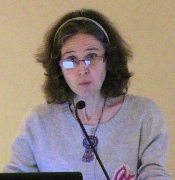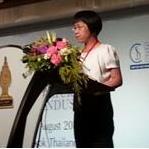Day 1 :
Keynote Forum
Ozlem Tokusoglu
Celal Bayar University, Turkey
Keynote: Food by-products based food powders for functional nutrition and as anticancer agents
Time : 09:45-10:25

Biography:
Özlem TokuÅŸoÄŸlu has completed her PhD at Ege University Engineering Faculty, Dept. of Food Engineering in 2001. She is currently working as Associate Professor; Dr. Faculty Member in Celal Bayar University Engineering Faculty Department of Food Engineering. She performed a Visiting Scholar at the Food Science and Nutrition Department /University of Florida, Gainesville-Florida-USA during 1999-2000 and as Visiting Professor at the School of Food Science, Washington State University, Pullman, Washington,USA during April-May 2010. She has published many papers in peer reviewed journals and serving as an Editorial Board Member of selected journals. She published and scientifically edited two international books entitled “Fruit and Cereal Bioactives: Chemistry, Sources and Applications” and “Improved Food Quality with Novel Food Processing” by CRC Press, Taylor & Francis, USA Publisher, third book “Food By-Product Based Functional Food Powders” is in progress. She also published two national books entitled “Cacao and Chocolate Science and Technology” and “Special Fruit Olive: Chemistry, Quality and Technology”. She organized and/or administered as Conference Chair at many conferences and congresses in various parts of USA and Europe.
Abstract:
Food by-products in the food industry is characterized by a high ratio of product spesicific waste not only does this mean that the generation of this waste is unavoidable, but also that the level and the kind of by-product which consists primarily of the organic residue of processed raw materials, can scarcely be changed if the finished product quality is to remain consistent. Using and disposal of the product spesific waste is difficult owing to its inadequate biological stability, potential pathogenic structure, high water content, potential auto oxidation tendency and high amount of enzymatic activity. Food by-products or food industry shelf-stable co-products as liquid, pomace, or powder forms can be obtained from fruits, vegetables, meats, seafoods, milk and dairy, cereals, nuts, fats and oils processing. Those above-mentioned by-products may be evaluated as a source of dietary phytochemicals including phenolic antioxidants, carotenoids, bioactive other polyphenols, dietary fibers, as a source of proteins, peptides and aminoacids, may be evaluated as extruded products as a sources of collagen, gelatin, and as a sources of various food additive materials. However, some of the by-products can be utilized as compost for plants, can be used as animal feed and can be utilized as industrial materials. Epidemiological studies have pointed out that fruits and vegetable consumption imparts health benefits including certain types of cancer, reduced risk of coronary heart diseases. The health benefits of fruits and vegetables are majorly attributed to bioactive nutrients as phytochemicals, carotenoids, vitamines (ascorbic acid, tocopherol etc.), also to dietary fiber of these products. By-products of fruits and vegetables are sources of these healthy compounds and it has been considered that these are the highly desired constituents of by-products of fruits and vegetables. Seafood product processing discard account for about three-quarters of the total weight of catch. Seafood processing has also been used as a possible waste utilization. It is known that the major components of seafood discard products are tongue, cheeks, stomach, liver of fish, protein bioactives from residual fish, marine bioactive lipid components (omega 3,6, DHA,EPA), fish skin, carotenoid bioactives and chitinous materials from shellfish products, gut enzymes, flavor products, anti-freeze proteins from seafood blood. Nowadays, the potential utilization of the above-mentioned major components has been the focus of attention. Chemoprevention is an active cancer (CA) preventive strategy to inhibit, delay or reverse human carcinogenesis using naturally occurring or synthetic chemical agents. Studies have resulted that several new phytochemicals possess cancer preventive effect such as polyphenols. Several cellular mechanisms contribute to the overall cancer preventive effects of dietary phytochemicals. Signal transduction pathways are potential molecular targets for chemoprevention by dietary phytochemicals. Increasing expression of detoxifying enzymes and/or antioxidant enzymes inhibit the cell cycle progression and cell proliferation, induce the differantiation and apoptosis, inhibit the expression and functional activation of oncogenes, increase the expression of tumor-suppressor genes, inhibit angiogenesis and metastasis by modulating cellular signaling pathways. Dietary supplements and/or food fortification based on food by-product may be alternative for above-mentioned healthy constituents.
Keynote Forum
Alison Burton Shepherd
Vocare Group, UK
Keynote: Nutritional management of small bowel overgrowth
Time : 10:25-11:05

Biography:
Alison Burton Shepherd is a Registered Nutritionist (Scientist) and Senior Lecturer in Adult Nursing at De Montfort University Leicester UK. She is a part time Advanced Nurse Practitioner and Non-Medical Prescriber. Recently, she became an Inspector for the Care Quality Commission inspecting primary medical services to ensure that high standards of clinical care are being maintained. She is proud to be a Queens Nurse a title given to nurses who have achieved and continue to strive for excellence
Abstract:
SIBO is a condition in which the increased bacterial load in the small bowel results in excessive fermentation and inflammation, leading to a variety of clinical complaints ranging from mild, non-specific symptoms such as abdominal pain, bloating and flatulence, to more severe manifestations such as malabsorption and weight loss. The exact prevalence of bacterial overgrowth syndrome is likely underestimated because the clinical manifestations overlap with those of many other malabsorptive and diarrheal disorders. The advanced cases of bacterial overgrowth syndrome may manifest as malabsorption and therefore it is vital that this condition is detected in the early stages, so as to lessen the significant impact of malnutrition associated with malabsorption syndrome. Treatment in bacterial overgrowth syndrome (BOS) should include correction of primary underlying disease if any, including antibiotic therapy and nutritional support. This presentation will seek to explore the best treatments available for this challenging disorder
Keynote Forum
Yuanlong Pan
Nestle Purina Research, USA
Keynote: Optimal Nutrition for Promoting Healthy Brain Aging in Pets

Biography:
Yuanlong Pan completed his BVM from Gansu Agricultural University, P.R. China. Dr. Pan received his PhD in Animal Nutrition from Virginia Tech, USA and PhD in Human Nutrition from UNC-Greensboro, USA. Dr. Pan conducted research in the area of menopause and cognition at Wake Forest University School of Medicine from 1996 to 2000. In 2000, Dr. Pan joined Nestle Purina Research. He has published more than 18 papers, and obtained 78 patents. Dr. Pan won the Academy of Science-St Louis 2016 George Engelmann Interdisciplinary Award for his outstanding achievement in science through collaboration and become a Fellow of the Academy of Science- St Louis.
Abstract:
Aging affects all tissues and organs in humans and animals including dogs and cats. Some senior dogs and cats eventually develop cognitive impairment and dementia called cognitive dysfunction syndrome (CDS), a condition similar to Alzheimer’s disease in people. Since CDS is not a curable condition, our non-invasive research has been focused on nutritional strategies that promote healthy brain aging in dogs and cats. We have developed two nutritional solutions to enhance cognitive functions in dogs and cats. The first solution is to address the reduced ability of aging brain cells to utilize glucose as energy by feeding medium chain triglycerides (MCTs), and our studies have confirmed that MCTs enhance cognition in aging dogs. The second nutritional solution is to minimize known risk factors associated with brain aging. Since there are multiple risk factors, we have developed a nutrient blend targeting those risk factors and confirmed that the nutrient blend significantly enhances cognitive functions in middle-aged and aging cats. In summary, our research demonstrates that optimal nutrition can enhance cognitive functions in healthy aging dogs and cats. What we have developed for pets will help facilitate the development of similar nutritional solutions for people.
Keynote Forum
B K Iyer
AstaReal Group, Singapore
Keynote: Can evidence based nutraceuticals fill need gaps in clinical practice?
Time : 12:00-12:40

Biography:
B K Iyer is a Physician in clinical practice since last 34 years but is not the typical run-of-the-mill Health Care Practitioner but is actively involved in research, too. He has utilized his diverse exposure across the multiple disciplines of clinical medicine to his advantage and with varied exposures and responsibilities in the health science orbit, he is devoted to plugging the need gaps in clinical practice. With more than 33 years of experience as ‘Medical Advisor’ to many pharmaceutical companies in India & abroad, he is well versed with the various therapeutic categories and diverse, disease segments. By providing insights as a Clinical Practitioner, he helps, in a large measure to frame unique strategies and carve outstanding EBM solutions. His repertoire of work is varied from cardiology – to immunology – to infectious diseases – to neurology - to dermatology – to nutraceuticals, as well as in the area of diabetes management. He regularly attend conferences to stay abreast of the latest in clinical sciences, his interests, research and involvement include the diverse space of biotechnology & medical diagnostics, too.
Abstract:
Current therapeutic expectations of clinicians far exceed the clinical efficacy provided by pharmaceuticals and biologics, especially in diseases where there are clinically evident need gaps. Advances in technology enable science to examine the application of complementary and alternative medicine in such areas. One such clinical need gap area devoid of effective solution, to date, is fatigue – currently, a common social problem. But, the fact is that no patient ever rushes to a clinician complaining of fatigue. The common expression is a complaint of weakness and the clinician attempts intervention with nutritional correction. The general complaint of tiredness also meets a similar recommendation from the clinician for adequate rest. So, then, what exactly is fatigue? Fatigue is the tiredness not relieved by persistent rest and the failure to maintain the expected force or required functioning capability. Fatigue is an outcome of stress that exceeds the resistance threshold and, uncontrolled fatigue forms one of the critical components of Chronic Fatigue Syndrome. But, although fatigue is synonymous with peripheral skeletal muscles; mental fatigue [affecting the brain cells] is also common and may either occur together or solo. Likewise, just as fatigue can affect the skeletal muscles; fatigue can also affect muscles in other regions, e.g.: Eye muscles, vocal cord muscles, etc. In fact, fatigue is also a substantial complaint in post myocardial infarction patients despite the corrective interventions of CABG or angioplasty. With no current therapies providing relief in such fatigue cases, it is rational to examine evidence based nutraceuticals; as combating fatigue is a demand of equal value and enable total recovery. However, such recommendation must be a universal call to action, extracted from the efficacy studies across the entire spectrum of fatigue manifestations. One approach to effective control of fatigue [at every stage of the spectrum] is to rectify the mitochondrial dysfunction and restrict the unresolved inflammation from disrupting the signaling pathways. Such a missing jigsaw piece that fits perfectly across the entire spectrum of fatigue and offers evidence based efficacy; is the super nutrient- astaxanthin. By controlling oxidative stress as well as impacting inflammation; the eagerly awaited, extensively studied Fatigue Fighting Formula (FFF) that is widely effective, is natural astaxanthin of marine origin. Studies have shown how natural astaxanthin from AstaREAL provides structural stability to the muscle cells as well as functional integrity to the mitochondria, thus controlling fatigue in a unique manner. With the convenience of oral administration and the benefits of 8 novel, inbuilt properties of natural astaxanthin, it is now easy to grab the resilience offered by natural astaxanthin. By offering endurance to withstand stress and correcting the dysfunctional mitochondria, natural astaxanthin [AstaREAL from Japan] helps overcome fatigue effectively and prevent premature burnouts. Clinical evidence of efficacy of natural astaxanthin in fatigue has catalyzed this adoption, and, it is a matter of time before this efficacy gets the due respect in all fatigue patients. Experiential learning and self-realization will surely enable hopeless fatigue to be transformed into helpful rejuvenation. Is this the beginning of such evidence based nutraceuticals to be explored in clinical need gaps?
- Food Science & Chemistry| Nutraceuticals & Medicinal Foods | Nutrition, Health & Aging Clinical Nutrition | Pediatric & Maternal Nutrition
Session Introduction
Harmit Singh
California State Polytechnic University, USA
Title: Analysis of natural red cabbage color concentrated using membrane filtration

Biography:
Harmit Singh’s research is focused on the promotion of more acceptable natural food ingredients and bio-friendly food processing technologies such as membrane and enzyme technologies. His recent projects include purification and concentration of natural food colors using membrane technology and evaluation of antioxidant properties and stability of these colors during application. His research is also focused on application of enzymes as processing aid to affect protein solubilization, allergen degradation and other food industry processes.
Abstract:
Statement of Problem: Membrane technology has become a potential technique to remove unwanted molecules and concentrate the natural colors without thermal treatment. However, this technology needs to be investigated for the efficiency and changes in ACNs quality throughout the process. The Purpose of this was to purify and concentrate ACN extract from red cabbage using membrane filtration; and to compare the color intensity, aroma, the antioxidant capacity, phenolic content and chemical composition of the purified anthocyanins.
Methodology: ACNs were extracted from red cabbage by constant agitation using a 0.5% HCl solution. The extracted suspension was centrifuged and clarified using Microfiltration (MF) membrane to remove any unwanted particles. The resulting permeate with color was collected and concentrated using Nanofiltration (NF). The final permeate and retentate were analyzed for composition and other characteristics. Reverse Phase High Performance Liquid Chromatography (RP-HPLC), colorimeter, antioxidant capacity and total phenolic content were used to evaluate any changes.
Findings: There was a 42% decrease in total phenolic content from raw sample to concentrated sample, while the antioxidant capacity remained the same at 16 mg/L throughout the whole process. No change in RP-HPLC was observed throughout the purification process indicating the concentration process did not affect ACNs composition. The NF membrane proved to have a good anthocyanin retention since no anthocyanin content was found in the permeate. Interestingly, the undesirable aroma from red cabbage was less intense in the concentrated sample as compared to the raw sample and will need further study.
Pinar Terzioglu
Mugla Sitki Kocman University, Turkey
Title: Influence of baking and extraction methods on the fatty acids and antioxidant activity of the poisonous mushroom tricholoma terreum from Turkey

Biography:
Sevil Yücel has received the PhD at Istanbul Technical University, Department of Chemical Engineering in 1991. She began working at Yildiz Technical University, Department of Bioengineering in 2006 as Assist. Prof. and worked at the same department with the title of Assoc. Prof. between 2009-2014 years. She is still working at Yildiz Technical University, Department of Bioengineering as professor till 2014. Sevil Yücel has many research papers published in SCI indexed journals and by the international indexed journals, book chapters and international meetings
Abstract:
Mushrooms have long been part of the human nutrition. In recent years, mushrooms have attracted much research attention due to being important natural resources of bioactive compounds, antibacterial, antioxidant, and anticancer agents. Tricholoma terreum (Schaeff.) P.Kumm. is an edible mushroom growing in many districts of Europe; however, the fruiting bodies of this wild mushroom was suspected as toxic and should be consumed after cooked [1]. In the present study, T. terreum were collected from MuÄŸla, Turkey. The influence of baking on the fatty acid profile and antioxidant activity of the extracts of T. terreum obtained by traditional, Soxhlet and ultrasonic assisted extraction technique was investigated. The fatty acid profile and antioxidant properties based on free radical scavenging activity was studied using GC-MS and spectrophotometer, respectively. The fatty acid content and radical scavenning activity of mushroom extracts were varied by using on the bases of different solvent extractions and several extraction techniques. The linoleic and palmitic acid found to be the main fatty acids in baked samples while linoleic, linolenic and oleic acid in unbaked ones. When mushroom was baked, palmitic acid and linoleic acid percentages of all extracts increased, whilst linolenic acid decreased. Among the all extracts, the water extract of unbaked and baked mushroom obtained by Soxhlet extraction was found to be the most active on DPPH• assay. It was observed that the baked mushroom extracts exhibited less activity than those of raw extracts
Monira Pervin
University of Shizuoka, Japan
Title: Prevention of Age-related Cognitive Dysfunction: Mechanism of Action of Green Tea Catechins on Mouse Brain

Biography:
Monira Pervin has completed her PhD studies in Nutritional Biochemistry at Graduate School of Nutritional and Environmental Sciences, Department of Food and Nutritional Sciences, University of Shizuoka, Japan with thesis entitled: “Studies on biological effects of plant lectins on animal cells and tissues”. At present, she is working as postdoctoral research assistant in Tea Science Center, Graduate School of Integrated Pharmaceutical and Nutritional Sciences, University of Shizuoka, Japan on prevention of brain aging by green tea catechin using human neuroblastoma SH-SY5Y cells and mouse brain tissues. Her work has been reported in fifteen published paper in peer-reviewed Journals
Abstract:
The consumption of green tea catechins (GTCs) suppresses age-related cognitive dysfunction in mice. GTCs are composed of several catechins, of which epigallocatechin gallate (EGCG) is the most abundant, followed by epigallocatechin (EGC). Orally ingested EGCG is hydrolyzed by intestinal biota to EGC and gallic acid (GA). To understand the mechanism of action of GTCs on the brain, their permeability of the blood brain barrier (BBB) as well as their effects on cognitive function in mice and on nerve cell proliferation in vitro were examined. The in vitro BBB permeability (%, in 30 min) of EGCG, EGC and GA was 2.8±0.1, 3.4±0.3 and 6.5±0.6, respectively. The permeability of EGCG into the BBB indicates that EGCG reached the brain parenchyma even at a very low concentration. The learning ability of SAMP10 mice (a mouse model of brain senescence) that ingested EGCG (20 mg/kg) was significantly higher than of mice that ingested EGC or GA. However, combined ingestion of EGC and GA showed a significant improvement comparable to EGCG. SH-SY5Y cell growth was significantly enhanced by 0.05 µM EGCG, but this effect was reduced at higher concentrations. Co-administration of EGC and GA increased neurite length more than EGC or GA alone. These results suggested that cognitive dysfunction in mice is suppressed after ingesting GTCs when a low concentration of EGCG is incorporated into the brain parenchyma via the BBB. Furthermore, the additive effect of EGC and GA suggests that EGCG sustains a preventive effect after the hydrolysis to EGC and GA.
Hiromi Murakami
Osaka Municipal Technical Research Institute, Japan
Title: Microbial Conversion of Lactose to Calcium Lactobionate
Time : 15:30-16:00

Biography:
I have been working at Osaka Municipal Technical Research Institute since graduating from KONAN University in Kobe, Japan, and have been engaged in research into microbial enzymes, such as glycosidases, glycosyl transferases, oxidases. I received a doctoral degree on “Levan degrading enzymes”. I have also been interested in enzymatic and microbioal oxidation of saccharides. Productions of Lactobionic acid, D-glucuronic acid and D-glucaric acid are good examples for effective conversion of aldose to aldonic acid, uronic acid and aldaric acid.
Abstract:
Objective: Concerned about utilization of lactose and development of high-soluble calcium supplement, with an interest on biological oxidation of oligosaccharide, we examined microbial and enzymatic oxidation of lactose and aimed to establish effective production systems of calcium lactobionate. Lactobionate, b-1,4-D-galactosyl-D-gluconate, is an oxidized product of lactose. It has been reported to have mineral-absorption-promoting effects, Biffidobacterium-growing activity, moisturizing effect, and high solubility in water. Despite its useful properties, lactobionate has been supplied only in a small scale by chemical oxidation because there is no easy and efficient way to produce it.
Results: As for fermentation, we isolated a mutant strain of Burkholderia cepacia which has no b-galactosidase activity to avoid hydrolysis of lactose and has sugar-tolerance to react with concentrated lactose. After 4-day cultivation, lactose was completely disappeared and the equivalent molarity of calcium lactobionate was accumulated. In the case of 10-day-fed-batch culture, the final concentration of the product reached 400 g/L in 100% yield. The product was purified from culture supernatant by ethanol precipitation.
As for microbial conversion, cells were incubated with 100 to 200 g/L of lactose and half mole equivalent calcium carbonate to lactose. The oxidation activity of the cells was defined as the amount of cells which produced 1 mmol of D-gluconate per minute from 0.1M D-glucose under the assay conditions. When 2 U/mL of cells were incubated with 100 , 150 and 200 g/Lof lactose, it took 18, 27 and 48 h for 100% conversion. Reuse of resting cells was available for repeated conversions. Cells of Gluconobacter sp.were also used for microbial conversion. As for enzymatic conversion, we isolated a strain of Paraconiothyrium sp. which secreted a stable oxidase in culture. These biological conversion systems of lactose were effective to produce calcium lactobionate with high yield, no by-product, easy purification, and easy operation in one-pot synthesis.
Dina Keumala Sari
University of Sumatera Utara, Indonesia
Title: Vitamin D supplementation increased 25(OH)D serum levels but did not reach normal range in North Sumatera women with vitamin D receptor gene polymorphism

Biography:
Dina Keumala Sari has her expertise in vitamin D and polymorphism vitamin D receptor gene. Her interest in vitamin D creates a theory about microevolution in North Sumatera women in Indonesia
Abstract:
Background: A large proportion of women living in tropical regions experience Vitamin D deficiency especially in North Sumatera, Indonesia, and lifestyle being one of the predisposing factors. Other causes may be attributed to the presence of polymorphism in the Vitamin D receptor gene TaqI and BsmI.
Objective: To assess the effect of 1000 IU vitamin D supplementation on 25(OH)D serum and calcium levels in North Sumatera women with vitamin D re ceptor gene polymorphism (TaqI and BsmI).
Design: The study was a parallel clinical trial, thirtysix subjects with vitamin D receptor gene polymorphism (TaqI and BsmI) were selected using certain criterias. The subjects were devided into two groups using block randomization. Nineteen subjects in vitamin D group received 1000 IU vitamin D supplementation per day and dietary counseling (D), while seventeen subjects in counseling group received placebo and dietary counseling (C). Serum 25-hydroxyvitamin D and calcium levels were assessed on day 0 and 28. Before and after treatment, dietary intake were assessed with 2x24 hour recal methods.
Results: Nineteen subjects in D group and seventeen subjects in C group completed the study. There was no significant differences in baseline data both groups. After 28 days treatment, there was no significant differences in nutrients intake in two groups except vitamin D intake in D group. There was significant increase in 25(OH)D serum level in D group while no change was observed in the C group (p=0.04). Serum calcium concentration showed no significant change in both groups. There was significant differences between both group but all subjects did not reach normal value in 25(OH)D serum level (normal value >30 ng/mL).
Conclusions: The result shows that vitamin D deficiency can occur in women with Vitamin D receptor gene polymorphism even already supplemented with 1000 IU vitamin D.

Biography:
Alison Burton-Shepherd is a Registered Nutritionist (Scientist) and Senior Lecturer in Adult Nursing at De Montfort University Leicester UK. She is a part time Advanced Nurse Practitioner and Non Medical Prescriber. Recently she became an Inspector for the Care Quality Commission inspecting primary medical services to ensure that high standards of clinical care are being maintained. She is proud to be a Queens Nurse a title given to nurses who have achieved and continue to strive for excellence.
Abstract:
Chemo-radiotherapy (CRT) causes or exacerbates symptoms, such as alteration or loss of taste, mucositis, xerostomia, fatigue, nausea and vomiting, with consequent worsening of malnutrition. It is well known that radiotherapy is invariably associated with mucositis, xerostomia, dysphagia, haematological toxicities and other acute side effects, whose incidence increases when chemotherapy is also administered, and that oral mucositis incidence leads to higher unplanned breaks and delays in radiotherapy administration. In addition, in many patients such toxicities may be very severe and even life threatening and may lead to treatment interruptions that are invariably associated with poorer outcome.
This presentation will review best practice in the nutritional management of patients undergoing chemotherapy and radiotherapy
Iris Shai
Ben Gurion University, Israel
Title: Dynamic of human adipose tissues and ectopic fat deposits induced by different lifestyle interventions: a long-term MRI randomized trial

Biography:
Iris Shai is a professor of Nutrition and Epidemiology at BGU and a visiting Scientist at Harvard School of Public Health in the field of nutrition and chronic diseases. Her focuses are long-term, compressive dietary randomized controlled trials (RCTs), performed in standards of drugs trials, and long-term cohorts. Following her fellowship in Harvard School of Public Health, she performed the 2-year Dietary Intervention Randomized Controlled Trial (DIRECT) and 4-year follow-up, comparing the effects of low-fat, Mediterranean and low-carb diets on cardiometabolic risk and plaque regression. In her next RCT she addressed the 2-year effect of moderate alcohol in type 2 diabetes and her current whole-body MRI RCT focus on dynamic of human specific fat depots and fuel metabolism across dietary strategies
Abstract:
BACKGROUND: It remains unclear whether specific lifestyle strategies can differentially mobilize fat depots/ectopic-fat-deposits.
METHODS: During an 18-month trial in an isolated workplace with monitored, provided lunch, we randomly assigned participants with abdominal obesity/dyslipidemia to iso-caloric low-fat(LF) or low-carbohydrate/Mediterranean(LC/MED) diets. After 6 months, we re-randomized half of each arm to moderately-intense physical-activity (PA+;80%-aerobic; free gym membership). We performed whole-body magnetic-resonance-imaging (3-Tesla-MRI) at 0,6,18 months
RESULTS: Of 278 randomized participants [age=48yr;88% men; body-mass-index=30.8kg/m2) 86.3% completed the trial. While the caloric deficit was similar, the LF group preferentially decreased saturated/unsaturated fats (p<0.001), and the LC/MED decreased carbohydrates (p<0.001) and trans-fat intake (p=0.029 vs. other diet). The PA+ group increased their MET/wk (p=0.009 vs. PA-). Fat depots/deposits were significantly reduced to different degrees [Hepatic:(-32%);deep-subcutaneous-adipose-tissue(SAT):(-29%);visceral-adipose-tissue(VAT):(-25%);superficial-SAT:(-19%) and intra-pericardial:(-14%(-25mL))], with lesser changes of renal:(-9%);intermuscular:(-2%) and pancreatic-fat:(-1%). Although weight loss was comparable, LC/MEDPA+ favorably reduced waist-circumference (p<0.05), and induced -14% further loss of intra-pericaridal;p=0.003, -4% VAT;p=0.037 and -1.9% pancreatic-fat;p=0.007, compared to LFPA- changes (reference-group; weight-loss-adjusted for all). LC/MED decreased hepatic fat beyond LF diet by -15%;p=0.044. Conversely, renal-sinus and femoral-intermuscular fat dynamics were similarly altered by lifestyle strategies. VAT and intrahepatic fat loss associated with an improved lipid profile, and deep-SAT loss with improved glycemic control.
CONCLUSIONS: Human depots/ectopic-fat-deposits are substantially variable in their capacity to respond to different long-term moderate weight-loss strategies. LC/MED diet, particularly with PA, can favorably enhance fat mobilization in several depots. These findings may suggest defined lifestyle protocols for targeting specific fat storage sites.
Yuanlong Pan
Nestle Purina Research, USA
Title: Optimal Nutrition for Promoting Healthy Brain Aging in Pets

Biography:
Yuanlong Pan completed his BVM from Gansu Agricultural University, P.R. China. Dr. Pan received his PhD in Animal Nutrition from Virginia Tech, USA and PhD in Human Nutrition from UNC-Greensboro, USA. Dr. Pan conducted research in the area of menopause and cognition at Wake Forest University School of Medicine from 1996 to 2000. In 2000, Dr. Pan joined Nestle Purina Research. He has published more than 18 papers, and obtained 78 patents. Dr. Pan won the Academy of Science-St Louis 2016 George Engelmann Interdisciplinary Award for his outstanding achievement in science through collaboration and become a Fellow of the Academy of Science- St Louis.
Abstract:
Aging affects all tissues and organs in humans and animals including dogs and cats. Some senior dogs and cats eventually develop cognitive impairment and dementia called cognitive dysfunction syndrome (CDS), a condition similar to Alzheimer’s disease in people. Since CDS is not a curable condition, our non-invasive research has been focused on nutritional strategies that promote healthy brain aging in dogs and cats. We have developed two nutritional solutions to enhance cognitive functions in dogs and cats. The first solution is to address the reduced ability of aging brain cells to utilize glucose as energy by feeding medium chain triglycerides (MCTs), and our studies have confirmed that MCTs enhance cognition in aging dogs. The second nutritional solution is to minimize known risk factors associated with brain aging. Since there are multiple risk factors, we have developed a nutrient blend targeting those risk factors and confirmed that the nutrient blend significantly enhances cognitive functions in middle-aged and aging cats. In summary, our research demonstrates that optimal nutrition can enhance cognitive functions in healthy aging dogs and cats. What we have developed for pets will help facilitate the development of similar nutritional solutions for people.
Shein-Chung Chow
Duke University School of Medicine, USA
Title: Challenges in clinical nutritional research: How adaptive design can help?

Biography:
Prior to joining Duke University, Chow was the Director of TCOG (Taiwan Cooperative Oncology Group) Statistical Center and the Executive Director of National Clinical Trial Network Coordination Center. Prior to that, Chow also held various positions in the pharmaceutical industry such as Vice President, Biostatistics, Data Management, and Medical Writing at Millennium Pharmaceuticals, Inc., Cambridge, MA; Executive Director, Statistics and Clinical Programming at Covance, Inc., Director and Department Head at Bristol-Myers Squibb Company, Plansboro, NJ; Senior Statistician and Research Statistician at Parke-Davis Pharmaceutical Division, Warner-Lambert Company, Ann Arbor, MI and Wyeth-Ayerst Laboratories, Rouses Point, NY. Through these positions, Chow provided technical supervision and guidance to project teams on statistical issues and presentations before partners, regulatory agencies or scientific bodies, defending the appropriateness of statistical methods used in clinical trial design or data analyses or the validity of reported statistical inferences. Chow identified the best statistical and data management practices, organizes and leads working parties for development of statistical design, analyses and presentation applications, and participated on Data Safety Monitoring Boards in clinical research and development. Chow's professional activities include playing key roles in many professional organizations such as officer, Board of Directors member, Advisory Committee member, and Executive Committee member. He has served as Program-chair, session-chair moderator, panelist and instructor faculty at many professional conferences, symposia, workshops, tutorials and short courses. He is the Editor-in-Chief of the Journal of Biopharmaceutical Statistics. Chow is also the Editor-in-Chief of the Biostatistics Book Series at Chapman and Hall/CRC Press of Taylor & Francis Group. He was elected Fellow of the American Statistical Association in 1995 and an elected member of the ISI (International Statistical Institute) in 1999. He was the recipient of the DIA Outstanding Service Award (1996), ICSA Extraordinary Achievement Award (1996), and Chapter Service Recognition Award of the American Statistical Association (1998). Chow was appointed as Scientific Advisor to the Department of Health, Taiwan in 1999-2001 and 2006-date. Chow was President of the International Chinese Statistical Association, Chair of the Advisory Committee on Chinese Pharmaceutical Affairs, and a member of the Advisory Committee on Statistics of the DIA.
Abstract:
Human studies are essential to obtain evidence of beneficial effects of nutritional interventions on health. Clinical nutritional development plans include a range from small pilot trials to well-designed confirmatory studies, following good clinical practices.
Nutrition interventions are generally safe compared to pharmaceutical compounds. Regulatory guidance limits the benefits of nutrition to the maintenance of normal function or the reduction of accepted risk factors. Therefore, nutritional trials do not necessarily follow the same development process as pharmaceutical products. The objectives focus more on maintaining health and preventing risk factors for disease rather than showing efficacy in disease conditions. Clinical trials in the nutritional field have specific challenges to overcome in terms of population, intervention, design and methodology. Additional challenges are the lack of learning phases, small beneficial effects, high heterogeneity of the responses and difficulties in finding appropriate endpoints.
In recent years, the use of adaptive design methods in clinical trials has received much attention due to its flexibility and efficiency in clinical development. In practice, adaptive design may provide the opportunity to modify certain aspects of the trial design whilst the study is still ongoing, without violating the quality and the integrity of the data. However, introducing more flexibility may come with many difficulties: major adaptations of on-going trials may result in designs unable to address the original scientific/medical questions. In addition, fundamental differences between pharmaceutical and nutritional research potentially trigger limitations but also opportunities for the application of such innovative design.
The aim of this work is to highlight specificities and challenges in nutritional clinical trials, review the concepts of adaptive design and then address the advantages, limitations, and feasibility of commonly considered adaptive designs. Statistical, clinical, operational and regulatory aspects of implementing adaptive designs will be discussed.
Hamish John Love
University of New England, Australia
Title: Self-control and Satisfaction with Dietary Behaviour

Biography:
Hamish Love is a researcher and PhD candidate at the University of New England in NSW, Australia. After completing his degree in Psychology with Honours at CSU he found his interest in psychology further honed to the intersection of nutrition/diet and psychology and has been researching and studying since. His current focus is on the implementation of healthier dietary practice through improved understanding of self-control
Abstract:
Statement of the Problem: Numerous health problems and cause of death have been attributed to dietary factors. However, further nutritional education alone is insufficient, as APA surveys have shown that although American participant’s most common goal was to improve their diet for better health, 94% of respondents were unable to do so and cited insufficient self-control as the main barrier to success. However, as yet there are no validated models of the relationships between self-control and dietary outcomes or moderating psychological constructs. Further, scales do not yet exist to measure these constructs to measure potential targets for clinical intervention or future research.
Aims: The current study is validating new scales for measurement of psychological-nutritional constructs in self-control for dietary satisfaction.
Methodology & Theoretical Orientation: 3 new scales are under development and validation using factor analysis and convergent/divergent validity with existing scales. Based on previous models of self-control, a new model of self-control for satisfaction with dietary behavior will be tested.
Findings: The scales to be created for model testing are currently being validated, with research scheduled to be completed by March 2017. Conclusion & Significance: The creation of the scales displayed in Figure 1, a proposed model of self-control for satisfaction with dietary behavior, will contribute improved understanding of how self-control and related constructs interact with dietary goals to predict dietary outcomes for better health.
Daniel R. Calvo
Biopolis, Spain
Title: New trends within the probiotics market: how producers should deal with them

Biography:
Daniel is the Marketing & Communications Manager at Biopolis, a Spanish based biotech company producer of probiotics. He has expertise within the probiotics and food supplement industry by designing and developing new product ideas, communicating them (EFSA and FDA related issues) and giving marketing and promotion support to Biopolis’ clients and partners. He has previously worked in Coca-Cola and Millward Brown (both in Germany) and in Natraceutical in Spain. He holds an MSc in Food Economics & Marketing (University of Reading) and BSc in International Marketing & Communications (Hochschule Bremen and University of Valencia).
Abstract:
It is undeniable the fact that the probiotic market is suffering a transition where new trends are coming across. In addition to this, regulation (by means of EFSA in Europe) is extremely relevant. New trends and Health Claim Regulations entail new challenges and impact on innovation.
Furthermore, the industry is moving at a fast-growing pace so that products containing probiotics are attractive to both food and pharma companies.
New indications from different nature -the so called third generation claims- appear more and more as hot topics/niches (atopic dermatitis, psoriasis, stroke, sport nutrition, gut-brain axis), abandoning soft communications such as digestive health or immune system support.
In this sense, new and interesting final product ideas are being developed within the industry, where probiotic producers should acquire a relevant role, going together with pharma and food industry based companies as well as contract manufacturers in order to create outstanding synergies and fulfill new market needs.
Yuxiao Zou
Guangdong Academy of Agricultural Sciences, China
Title: Silkworm pupae oil exerts hypolipidemic and antioxidant effects in a rat model of high-fat diet-induced hyperlipidemia

Biography:
Zou Yuxiao has her expertise in Food Chemistry and Nutrition. Her research program addresses all aspects of sericulture resources and Characteristic Lingnan fruits/vegetables nutrition, bioactive substances and the related functional evaluation since 1998. She has hosted more than 20 items of national projects, including the National Natural Science Foundation of China, National Science and Technology Support Program and National Public Welfare Industry Science and Technology Program. Since 2005, she won 8 prizes in provincial and ministerial level, including 3 first prizes (rank 3, 5, 8) 3 second prizes (rank 7, 10, 13) and 2 third prizes (rank 7, 9). She was authorized 24 pieces of invention patent, edited 5 books, published 65 articles and involved in the establishing of 4 items of enterprise product standard. During June 2010 to May 2011, she was in the Tufts University for further study with the funding from China Scholarship Council.
Abstract:
Silkworm pupae are good resources of edible oil that is especially rich in unsaturated fatty acids and considered an excellent dietary supplement for hyperlipidemia. In order to investigate the effects of silkworm pupae oil (SPO) on the lipid profile and oxidative stress, dyslipidemic-diabetic Wistar rats (n = 50) were divided into five diet groups of 10: normal control (C); high-fat diet control group (HF); and three other groups fed a high-fat diet with SPO supplementation (1, 2, or 4 mL•kg-1•d-1) orally. Groups fed with SPO had significantly lower concentrations of serum total cholesterol (TC) (P<0.05) and low-density lipoprotein cholesterol (LDL-C) (P<0.05) compared with the HF group. In regard to antioxidant parameters, except for levels of glutathione peroxidase (GSH-Px) in the liver, 2 and 4 mL•kg-1•d-1 of SPO supplementation leaded to higher total antioxidant capacity (T-AOC) (P<0.05), superoxide dismutase (SOD) (P<0.05) and GSH-Px levels (P<0.05) and lower malondialdehyde (MDA) levels (P<0.05) both in serum and liver versus the HF group. The study indicated that supplementation with SPO can improve lipid profiles and alleviate oxidative stress in dyslipidemic-diabetic rats induced by high-fat-diet, which showed great potential in ameliorating disorders of glucose and lipid metabolism.

Biography:
She studied nutrition at the Faculty of Medicine of Autonomous University of Yucatan where she now is teaching. Maria Luisa holds a master’s degree in Epidemiology from the National Institute of Public Health of Mexico, and she hold a PhD at Loughborough University. She is interested in the study of human growth, development, obesity, and body composition. During the last six years, she took part in a radio program on nutrition and health in Radio Universidad, in Merida. She has offered clinic consultations on obesity and eating disorders. She holds a Certificated like CONCER since 2016 and CONCAPREN since 2008 from Mexico. Also, holds a SNI level 1. At present, she works as teacher in the degree in nutrition at the Faculty of Medicine of UADY and researcher too. She is researcher supports in projects of the Cinvestav. She is also a teacher of Mexican dance and loves eating chocolates
Abstract:
Mexico has a high prevalence of stunting in children and adolescents, due to poor nutrition. Paradoxically, too many Mexican children and adolescents are currently overweight or obese (OW/OB). The dual-burden of stunting (low height for age) and OW/OB are nutritional conditions that increase the risk of developing chronic degenerative diseases in adulthood. The persistence of high levels of stunting in southern regions of Mexico, such as Yucatan, may be due to diet changes (nutrition transition) that Yucatecan population has experienced in recent years. Vitamins, such as folic acid (FA) and VB12 are micronutrients necessary for normal metabolism and growth. The relationships between the intake of these micronutrients and growth rate were identified. The impact of micronutrient consumption on body composition was also investigated. The sample population comprised 273 adolescents (152 females) aged 10-18 years, from Merida, Mexico. Dietary information was obtained using a food frequency questionnaire (FFQ) covering 106 local foods. Anthropometric and body composition measurements were taken, and socioeconomic data were gathered. Data were collected between September 2011 and July 2012. Over 50% of participants had inadequate consumption of both vitamins: 64% had inadequate intake of FA and 69% of VB12. Almost half (46.9%) were either short or stunted, and 33% were at risk of OW/OB. A higher risk of presenting OW/OB was found for participants with FA intake less than the RDI of 400 μg/day and for those with VB12 intake less than the RDI of 2.4 μg/day. No relationship was found between body fat percentage and the consumption of FA or VB12
Reyna MarÃa Cruz-Bojorquez
Autonomous University of Yucatan, Mexico
Title: Effect of diet rich in lycopene and exercise on blood lipids in adults with dyslipidemia

Biography:
She studied nutrition at the University of Veracruz, Reyna holds a postgraduate in Teaching Specialization and Master in Higher Education in the Autonomous University of Yucatan in Merida and she holds a science doctorate in Physical Activity and Sport at the University of León getting Cum Laude. Holds a Teacher certification by the Company CONOCER since 2010. Works experiences were in Mexican Social Security Institute (IMSS) in the hospital area: 1984-1997 and Medical Network in the clinic consultations: 1997-2000. At present, she works in the Autonomous University of Yucatan, Faculty of Medicine, Bachelor of Nutrition Teaching: 1997 to date. She is interested in the study of Health self-care, eating disorder and cardiometabolic diseases
Abstract:
Objective: To determine the effects of a diet rich in lycopene, the practice of physical exercise or association between them on levels of blood lipids in adults with dyslipidemia.
Material and Methods: It is an experimental study with duration of 12 weeks. The diet was designed rich in lycopene (50mg / day), the standard diet and exercise program. Before and after the intervention lipid profile of the participants was determined. Involved people between 21 and 64 years old, randomly divided into 4 groups: two standard diet (one did exercise and one not), and the other two with diet rich in lycopene, one did exercise and one not. For each indicator behavior regarding their group arithmetic mean and standard deviation were used. Later ANOVA was used to demonstrate the significance and finally the post hoc Tukey test.
Results: 48 participants completed the study of which 35.4% (17) were male and 64.6% (31) female. The mean differences were significant post-pre cholesterol (p = 0.004) and LDL (p = 0.001). The mean difference between groups was significant for cholesterol between the standard diet with exercise and diet rich in lycopene with exercise and vice versa (p = 0.002). For the LDL was significant difference between the standard diet and exercise group with the other groups.
Conclusions: The lycopene-rich diet (50 mg / day) for 12 weeks significantly reduce LDL cholesterol levels and blood. Exercise training (4 days a week for 60 minutes) for 12 weeks significantly decreased blood levels of LDL when combined with the standard diet and cholesterol levels and LDL to be associated with diet rich in lycopene.
Farag Saleh
King Faisal University , Saudi Arabia
Title: Fortification of Some Date Products with Microencapsulated Probiotic Bacteria

Biography:
Farag Ali Saleh has completed his PhD at the age of 32 years from Cairo University. He is the Prof of Food Science and Nutrition. He has published more than 26 papers in reputed journals and serving as an editorial board member of repute. He is member in many professional societies. He has attended more than 17 national and international conferences and scientific symposia
Abstract:
Recently, scientists interested in functional food, especially probiotic food which has many health benefits. Probiotic microorganisms expose to many risks during their presence in food products and after passing through gastrointestinal tract as well. Therefore, the a main goal of this study to try to keep probiotic bacteria alive in date products during storage period and after eating. Free and calcium alginate microencapsulated Bifidobacterium lactis Bb-12 were mixed with date paste and date syrup (Dibs) and exposed to simulated gastrointestinal conditions, to observe its effects on viability of on B. lactis. The results showed that date paste and Dibs have a protective effect to the free bacteria and increased protection of encapsulated bacteria when compared to free bacteria without mixing with a date paste and Dibs. The viable counts of probiotic bacteria were numerated in date paste and Dibs during storage. At the end of the seventh week from storage period, the numbers of free B. lactis were reduced in both date paste and Dibs for up to 106 cfu/g, while the numbers of encapsulated bacteria remained at 107 cfu/g. The microencapsulated bacteria retained the numbers up to 106 cfu/g until week ten. The changes in pH values, production of organic acid and color of date paste and Dibs were monitored during storage period. The sensory analysis of date products fortified with probiotic bacteria were evaluated. The results showed that the addition of both free and encapsulated probiotic bacteria did not show any significant effect on the sensory properties of date products. This study has shown the microencapsulation protected Bifidobacterium lactis Bb-12 from the high sugars concentration of date products and simulated gastrointestinal conditions. Such of this product will provide an alternative probiotic food choice for consumers and could be particularly appealing to children.
Niranjnai Wickramasinghe
Curtin University, Australia
Title: Phytoestrogen content of fermented lupin (tempeh and natto)

Biography:
Niranjani Wickramasinghe is currently pursuing PhD in Public Health at Curtin University, Perth, Australia. She has completed her MSc from University of Peradeniya Sri Lanka and Bachelor of Science degree from The Open University of Sri Lanka. She has worked as a Clinical Dietitian and Obesity Management Dietitian in Sri Lanka and United Arab Emirates. She has submitted four articles from her PhD study for publication
Abstract:
Natto and tempeh are indigenous Asian soya fermented foods which were originated in Japan and Indonesia, but now also being consumed in all over the world. Importantly these soya based fermented foods are rich in phytoestrogens genistein and daidzein. Phytoestrogens are plant derived isoflavone compound which has similar structure and antagonize human estrogens. While some of previous research indicates that phytoestrogen may act as anti-carcinogenic agents and inhibits tumor growth in patients with breast cancers, some of the other scientific literature says that “they stimulate tumor growth and therefore leading to practical issue for safety of food with phytoestrogen such as soya. Also some of research data say that phytoestogens have increasing attention due to the beneficial effect on glucose, lipid metabolism (protection against cardiovascular diseases), osteoporosis and complications related to menopause. However these health benefits of soya and phytoestrogens are controversial issue as number of research findings has indicated inverse results as well. Moreover contrasting results have been recorded on its cancer protection ability (hormone dependent cancers such as breast and prostrate) and due to these negative findings health authorities of some countries have indicated maximum daily intake level for phytoestrogen. Therefore preparation of indigenous Asian fermented legume foods such as natto and tempeh using other comparable legume is an interesting alternative to avoid overdosing above mentioned compounds. The aim of this study was to determine the amount of genistein and daidzein content of lupin and fermented lupin (lupin natto and tempeh) and whether fermentation time affected the genistein and daidzein content of lupin. Lupin tempeh and lupin natto were prepared using either whole seed (WS) or de-hulled seed (DHS). Analysis for genistein and daidzein content was conducted using HPLC for time points zero, 12 h, 24 h, 36 h, 48 h and 72 h after fermentation. Repeated measures ANOVA with source of lupin as between-subject factor was independently run for lupin tempeh and lupin natto. Results revealed that the amount of genistien and daidzein significantly increased with time in both tempeh and natto. Both isoflavones peaked at 48 h in lupin tempeh and earlier at 36 h in lupin natto. WS tempeh and WS natto had significantly more genistein than WHS tempeh and WHS natto. Diadzein content of WHS tended to be higher than WS across both products. It is concluded that, lupin and fermented lupin have very low amount of genistein and daizein compared to soya bean. Therefore, it is safe to consume without risk of phytoeastrogen overdosing. Fermentation time increased the amount of genistein and daidzein content in both lupin tempeh and natto and the form of lupin raw material used affected the genistein level and to some extent the daidzein content of fermented products.
